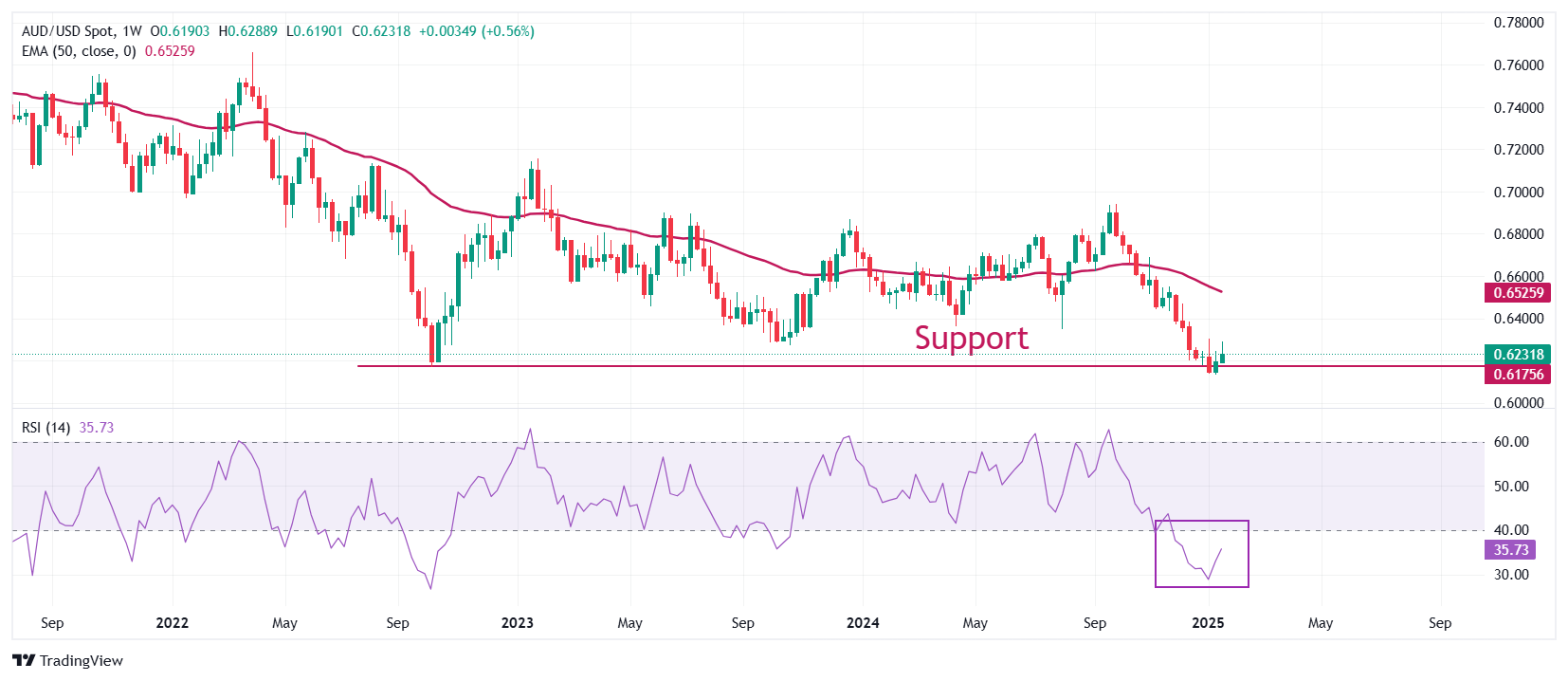AUD/USD Price Forecast: Trump’s tariff threats boost US Dollar
- AUD/USD slumps to near 0.6220 as Trump threatens to impose tariffs on China.
- The RBA is expected to start reducing interest rates in February.
- The US Dollar recovers sharply as Trump confirms that the tariff plan is on track.
The AUD/USD pair falls sharply to near 0.6220 in Tuesday’s North American session after a couple of failed attempts to revisit the key resistance of 0.6300. The Aussie pair slumps as United States (US) President Donald Trump threatens to raise tariffs on China, a move that would also hurt the Australian export sector, being the leading trading partner of China.
Trump’s presidential memo showed that he directed federal agencies to evaluate trade relationships with China and other North American economies.
Meanwhile, growing expectations that the Reserve Bank of Australia (RBA) could pivot to policy-easing in the policy meeting in February. RBA's dovish bets swelled after the board said in the December meeting that it gained some confidence that inflation is moving sustainably towards the target.
The US Dollar (USD) rebounds sharply and recovers most of Monday’s losses as Trump confirms that the tariff plan is still on. The US Dollar Index (DXY), which gauges the Greenback’s value against six major currencies, bounces back from an almost two-week low of 108.00.
AUD/USD discovers buying interest after revisiting an over four-year low of 0.6170. However, the outlook of the pair is still bearish as the 50-week Exponential Moving Average (EMA) near 0.6526 is sloping downwards.
The 14-week Relative Strength Index (RSI) bounces back after turning oversold near 30.00. However, the overall momentum will remain bearish until it stays inside the 20.00-40.00 range.
Going forward, the pair would face more downside if it fails to hold the January 13 low of 0.6131. This will push it lower to the round-level support of 0.6100 and the April 2020 low of 0.5990.
On the flip side, a decisive breakout above the January 6 high of 0.6302 will open doors to the December 18 high of 0.6340 and the round-level resistance of 0.6400.
AUD/USD weekly chart
Australian Dollar FAQs
One of the most significant factors for the Australian Dollar (AUD) is the level of interest rates set by the Reserve Bank of Australia (RBA). Because Australia is a resource-rich country another key driver is the price of its biggest export, Iron Ore. The health of the Chinese economy, its largest trading partner, is a factor, as well as inflation in Australia, its growth rate and Trade Balance. Market sentiment – whether investors are taking on more risky assets (risk-on) or seeking safe-havens (risk-off) – is also a factor, with risk-on positive for AUD.
The Reserve Bank of Australia (RBA) influences the Australian Dollar (AUD) by setting the level of interest rates that Australian banks can lend to each other. This influences the level of interest rates in the economy as a whole. The main goal of the RBA is to maintain a stable inflation rate of 2-3% by adjusting interest rates up or down. Relatively high interest rates compared to other major central banks support the AUD, and the opposite for relatively low. The RBA can also use quantitative easing and tightening to influence credit conditions, with the former AUD-negative and the latter AUD-positive.
China is Australia’s largest trading partner so the health of the Chinese economy is a major influence on the value of the Australian Dollar (AUD). When the Chinese economy is doing well it purchases more raw materials, goods and services from Australia, lifting demand for the AUD, and pushing up its value. The opposite is the case when the Chinese economy is not growing as fast as expected. Positive or negative surprises in Chinese growth data, therefore, often have a direct impact on the Australian Dollar and its pairs.
Iron Ore is Australia’s largest export, accounting for $118 billion a year according to data from 2021, with China as its primary destination. The price of Iron Ore, therefore, can be a driver of the Australian Dollar. Generally, if the price of Iron Ore rises, AUD also goes up, as aggregate demand for the currency increases. The opposite is the case if the price of Iron Ore falls. Higher Iron Ore prices also tend to result in a greater likelihood of a positive Trade Balance for Australia, which is also positive of the AUD.
The Trade Balance, which is the difference between what a country earns from its exports versus what it pays for its imports, is another factor that can influence the value of the Australian Dollar. If Australia produces highly sought after exports, then its currency will gain in value purely from the surplus demand created from foreign buyers seeking to purchase its exports versus what it spends to purchase imports. Therefore, a positive net Trade Balance strengthens the AUD, with the opposite effect if the Trade Balance is negative.

